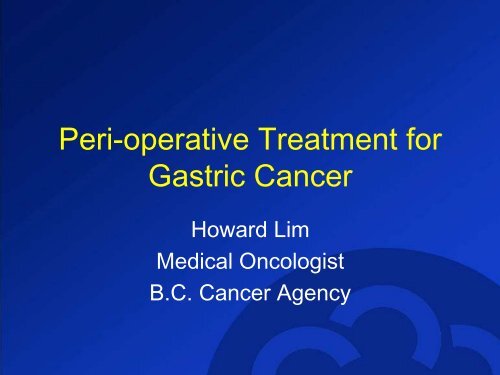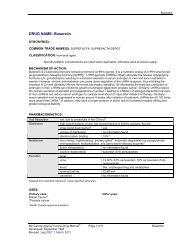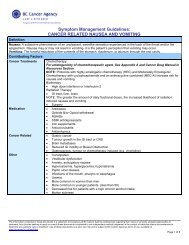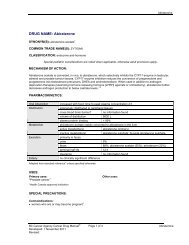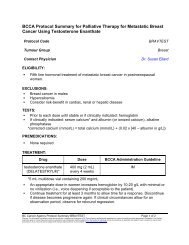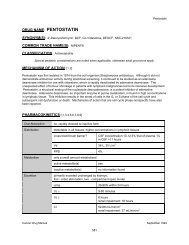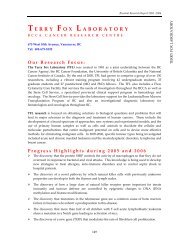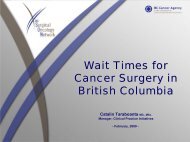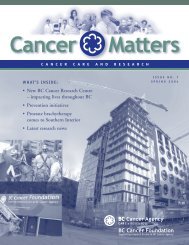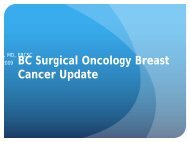Adjuvant and Neoadjuvant Therapy for Gastric Cancer - BC Cancer ...
Adjuvant and Neoadjuvant Therapy for Gastric Cancer - BC Cancer ...
Adjuvant and Neoadjuvant Therapy for Gastric Cancer - BC Cancer ...
You also want an ePaper? Increase the reach of your titles
YUMPU automatically turns print PDFs into web optimized ePapers that Google loves.
Peri-operative Treatment <strong>for</strong><strong>Gastric</strong> <strong>Cancer</strong>Howard LimMedical OncologistB.C. <strong>Cancer</strong> Agency
Esophagus <strong>and</strong> Stomach
Question• Is there a preferred perioperativetreatment <strong>for</strong> patients with gastriccancer?
Surgery6
The Goal – R0 ResectionEsophagealSCC(%)EsophagealAdeno-CA(%)<strong>Gastric</strong>Adeno-CA(%)pT1MucosaSubmucosa1009110010010098pT2848487pT3706860pT4485941Siewert et al. Ann Surg 1998; 228: 7 449-461Siewert et al. in Kelsen (Ed.) GI Oncology 2002; Table 18-3
Stomach Surgery - LymphadenectomyD1D2D3nodes adjacent to the stomach+ branches celiac axisnodes along the aorta
D1 versus D2 LymphadenectomyMorbidity 25% v 43%; P = .001Mortality 4% v 10%; P = .004Morbidity <strong>and</strong> mortality influenced- pancreatectomy- splenectomy- <strong>and</strong> ageHartgrink et al., J Clin Oncol 2004;22:2069-2077
D1 versus D2 LymphadenectomySubgroup with N2 diseaseHartgrink et al., J Clin Oncol 2004;22:2069-2077
D1 versus D3 Lymphadenectomy“D3 nodal dissection, compared with that of D1,offers a survival benefit <strong>for</strong> patients with gastric cancerwhen done by well trained, experienced surgeons.”Wu et al. Lancet Oncol 2006;7:309–15
<strong>BC</strong> ExperienceFigure 5 – Kaplan-Meier survival curves comparing margins
<strong>BC</strong> ExperienceFigure 3 – Kaplan-Meier survival curves comparing lymph node ratio. < 0.2 vs> 0.2
<strong>BC</strong> ExperienceFigure 4 – Kaplan-Meier survival curves comparing use of perioperativetreatment. a indicates chemotherapy +/- radiation, n indicates notreatment
Key to <strong>Gastric</strong> <strong>Cancer</strong>• Surgery is the key <strong>for</strong> curative intenttreatment• Chemotherapy <strong>and</strong> Radiation do notmake up <strong>for</strong> inadequate surgery• Peri-operative treatment still confers asurvival benefit16
Peri-operative chemotherapy17
UK MAGIC TrialSt. II + III<strong>Gastric</strong> +Junction +EsophagusN = 5031994-2002RANDOMChemotherapy:ECF x 3 Resection ECF x 3Primary endpoint: 5-y-survivalSurgery alone*ECF: Epirubicin 50mg/m2 d1, Cisplatin 60mg/m2 d1, 5-FU 200mg/m2/d cont iv, qd 2218Cunningham D et al. N Engl J Med 2006;355:11-20
UK MAGIC TrialMaximalDiameterCTXSURG3 cm 5 cmP-value
Chemotherapy250 pts assigned to chemotherapy (86%completed all 3 cycles)209 pts underwent surgery137 pts proceeded to postopchemotherapy37 pts disease progression10 post-op complications11 pt choice2 lack of response9 Other104 pts completed post-opchemotherapy (41.6% of 250 ptsinitially assigned)- After surgery – no increase ingrade 3/4 toxicity22
Surgery Details• Chemotherapy group – 229 (91.6%) pts went<strong>for</strong> surgery• Surgery within 3-6 weeks of completion ofchemotherapy• Post-operative complications were similar(45.7% vs 45.3%; chemo vs. no chemo),number of deaths at 30 days (5.6% vs 5.9%)<strong>and</strong> median stay in hospital 13 days bothgroups.23
UK MAGIC Trial5-y-OS36%23%24Cunningham D et al. N Engl J Med 2006;355:11-20
France FNCC 94012 - FFCD 9703St. II + III<strong>Gastric</strong> +Junction +N = 2241995-2003RANDOMChemotherapy:CF x 2 Resection CF x 4Primary endpoint: Survival20% 35% after 5 years, α=5%, β=20%Surgery alone*CF: Cisplatin 100mg/m2 d1, 5-FU 800mg/m2/d d1-5, qd 2825Boige, V. et al. ASCO 2007 #4510
France FNCC 94012 - FFCD 97031,000,800,600,40A risque0,200,00logrank : p = 0,0210 1 2 3 4 5 6 7111 79 53 38 27 16 13 7113 93 65 53 41 27 17 145-year-survival: 24% (16-33%) vs 38% (28-47%)26Boige, V. et al. ASCO 2007 #4510
<strong>Adjuvant</strong> Treatment27
<strong>Adjuvant</strong> Radiotherapy• Two early trials using radiation alone• Post-operative XRT vs. surgery alone 3yr OS 23 % vs 27 %• Intra-operative radiation vs surgery -Mean survival 26.9 months vs. 30.8month28 6
<strong>Adjuvant</strong> chemoradiationSWOG 9008 / INT 0116R0-resectedgastricRANDOMobservation5-FU/LV 5-FU/LV5adenocarcimoma5-FU/LVRadiation5-FU/LV x245 GyChemotherapyLeucovorin 20mg/m 2 d1-5, 5-FU 425mg/m 2 d1-5, qd28Modification cycle 2: leucovorin 20mg/m 2 d1-4, 5-FU 400mg/m 2 d1-4Modification cycle 3: leucovorin 20mg/m 2 d1-3, 5-FU 400mg/m 2 d1-3Macdonald et al., NEJM 2001; 345: 725-730
Surgical Details• Eligibility:– Curative intent en bloc resection of thetumor– Negative Margins– Recommended D2 – perigastric, celiac,splenic, hepaticoartery <strong>and</strong> cardial lymphnodes
Surgical Details• Of the 552 patients whose records werereviewed• D2 lymphadecotomy – 10% (52 pts)• D1 lymphadecotomy – 36% (199 pts)• D0 lymphadecotomy – 54%
<strong>Adjuvant</strong> chemoradiationSWOG 9008 / INT 0116Macdonald et al., NEJM 2001; 345: 725-730
<strong>Adjuvant</strong> chemoradiationSWOG 9008 / INT 0116Median OS:Chemo XRTSurgeryHR <strong>for</strong> death36 mos27 mos1.35 p=0.005Macdonald et al., NEJM 2001; 345: 725-730
Subset Analysis• At 10 ys f/u – HR 1.32 <strong>for</strong> OS <strong>and</strong> 1.51<strong>for</strong> DFS• Sex, race, T <strong>and</strong> N stage, D-level ofresection, tumor location, histology <strong>and</strong>Maruyama index• Chemoradiation benefitted all subsetsexcept women (HR 1.0) <strong>and</strong> diffusehistology (HR 0.97)ASCO 2009, Abstract 4515
Conclusions• ChemoXRT is recommended <strong>for</strong>resected gastric cancer• Majority of patients - D0/D1 surgery• Reflection of current practice• Sub group analysis did not reflect adifference between D0/D1/D2 resection• Small numbers37 15
<strong>Adjuvant</strong> S-1ATCS-GC studySt. II + IIID2-resectionR0n = 10592001-2004RANDOMchemotherapyS1: 1 yearPrimary endpoint: survivalHR 0.70; 〈=0.05; power = 80%observation*S1 (Tegafur, Gimeracil, Oteracil): 80mg/m² d1-28, qd 43Sakuramoto S et al. N Engl J Med 2007;357:1810-1820
The role of oral fluoropyrimidines: S-1New oral DPD-inhibiting fluoropyrimidin,developed by Taiho (Japan), consisting ofTegafur (FT), Gimeracil (CDHP) und Oteracil-Kalium (Oxo)in a molar ratio of 1 : 0.4 : 1++Tegafur (FT) Gimeracil (CDHP) Oteracil-K (Oxo)
The role of oral fluoropyrimidines: S-1Kubota T. Br J <strong>Cancer</strong> 2008; 98:1301.1304
<strong>Adjuvant</strong> S-1Relapse-free survivalOverall survivalHR = 0.62 (95% CI, 0.50 to 0.77)P
<strong>Adjuvant</strong> S-1Pattern of relapseSakuramoto S et al. N Engl J Med 2007;357:1810-1820
Conclusions• <strong>Adjuvant</strong> S1 improves OS by approx.10%• Majority of patients had D2 resection• May not be valid in D0/D1 resection• Asian vs. Western patients? - Severalstudies showing that there does notappear to be a genetic difference• When equivalent surgery per<strong>for</strong>med -treatment outcomes similar• S1 not approved in Canada45 23
<strong>Adjuvant</strong> Chemotherapy• Meta-analyses: analyses: only borderline significance <strong>for</strong> adjuvant chemotherapy.• Single studies: virtually all negative.• Subgroup analyses: stronger trend towards better survival with chemotherapy cinlymph node + disease.Meta-analysesStudies(n)Patients(n)Odds ratio (CI)Hermans 1993 11 2096 0.88 (0.78-1.08)Earle 1999 13 1990 0.80 (0.66-0.97)Mari 2000 21 3658 0.82 (0.75-0.89)Janunger 2002 21 3962 0.84 (0.74-0.96)Lordick F & Siewert JR. <strong>Gastric</strong> <strong>Cancer</strong> 2005; 8: 78-85
• Individual patient-level meta-analysis• 17 trials – 3838 patients representing60% of targeted data• Median f/u 7 years
• Median OS 4.9 yearssurgery only vs 7.8years in the adjuvantchemotherapy 5FUbased chemotherapy• HR <strong>for</strong> OS 0.82 p
Peri-operative treatmentOutcomes
<strong>BC</strong> Experience• <strong>Gastric</strong>/GE junction patients should beevaluated <strong>for</strong> consideration of perioperativetreatment• If not deemed to be a c<strong>and</strong>idate <strong>for</strong> preoperativetreatment – consider postoperativetreatment
Reasons <strong>for</strong> peri-operative• Significant benefit with 3 cycles of preoperativechemotherapy• Post-operative patients may not bec<strong>and</strong>idates <strong>for</strong> adjuvant treatment• Neo-adjuvant therapy can downstage disease– aid with achieving R0 resection• May weed out the poor per<strong>for</strong>ming patients(patients who progress on neo-adjuvanttreatment – will surgery really salvage them?)
<strong>BC</strong> Experience• Post-operative options:– ChemoXRT preferred – if poorly tolerated –try to complete the ChemoXRT portion– If anastomosis high, may not be suitable<strong>for</strong> XRT as field too large– Consider <strong>for</strong> adjuvant chemotherapy
<strong>Gastric</strong> <strong>Cancer</strong> Treatment SchemeECCSurgeryECCSurgery - D1 or D2 resection or >15 lymph nodesIf upfront surgery - bleeding, not eligible <strong>for</strong> chemotherapySurgeryChemoXRT - currently 5FUFuture - ECC/CP with XRT or ECC/CP aloneNot eligible <strong>for</strong> XRT - consider 5FU basedchemotherapy - ECC?55
Conclusions• All patients with localized/resectablegastric cancer should be referred preoperatively<strong>for</strong> consideration of perioperativetreatment• Surgical management should include aminimum of 15 lymph nodes or D1lymph node dissection56
Thank You!


